
In baseball statistics, a hit, also called a base hit, is credited to a batter when the batter safely reaches or passes first base after hitting the ball into fair territory with neither the benefit of an error nor a fielder's choice.

Softball is a popular variation of baseball, the difference being that it is played with a larger ball, on a smaller field, and with only underhand pitches permitted. Softball is played competitively at club levels, the college level, and the professional level. The game was first created in 1887 in Chicago by George Hancock.

The infield fly rule is a rule of baseball and softball that treats certain fly balls as though caught, before the ball is caught, even if the infielder fails to catch it or drops it on purpose. The umpire's declaration of an infield fly means that the batter is out regardless of whether the ball is caught. The rule exists solely to prevent the defense from executing a double play or triple play by deliberately failing to catch a ball that an infielder could catch with ordinary effort.
Dead ball is a term in many ball sports in which the ball is deemed temporarily not playable, and no movement may be made with it. Depending on the sport, this event may be quite routine, or more uncommon.
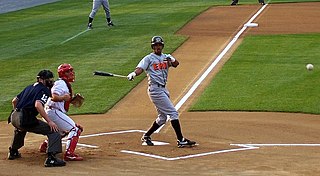
In baseball, a foul ball is a batted ball that:
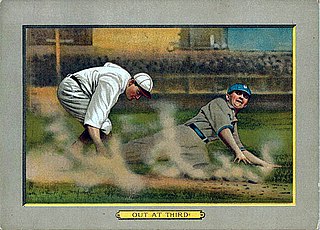
In baseball, an out occurs when the umpire rules a batter or baserunner out. When a batter or runner is out, they lose their ability to score a run and must return to the dugout until their next turn at bat. When three outs are recorded in a half-inning, the batting team's turn expires.

In baseball, to tag up is for a baserunner to retouch or remain on their starting base until (after) the ball is first touched by a fielder. By rule, baserunners must tag up when a hit ball is caught before it bounces by a fielder, and in such situations, are out if any fielder with possession of the ball touches their starting base before they do. After a legal tag up, runners are free to attempt to advance, even if the ball was caught in foul territory. On long fly ball outs, runners can often gain a base; when a runner scores by these means, this is called a sacrifice fly. On short fly balls, runners seldom attempt to advance after tagging up, due to the high risk of being thrown out.
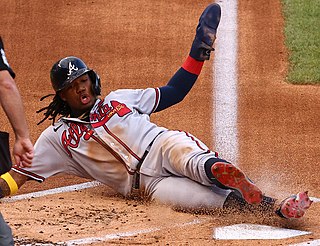
In baseball, a slide is the action of a player, acting as a baserunner, who drops his body to the ground once he is very close to the base he is approaching and slides along the ground to reach the base. Sliding is widely considered to be an essential component of baserunning in both baseball and softball.

Throughout baseball's history, the rules have frequently changed as the game continues to evolve. A few common rules most professional leagues have in common are that four balls are a base on balls, three strikes are a strikeout, and three outs end a half-inning.
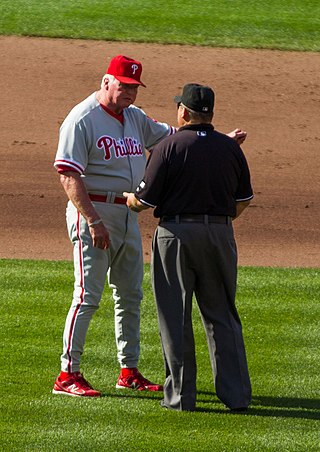
In baseball, an appeal play occurs when a member of the defensive team calls the attention of an umpire to an infraction that he would otherwise ignore.
In baseball, interference occurs in situations in which a person illegally changes the course of play from what is expected. Interference might be committed by players on the offense, players not currently in the game, catchers, umpires, or spectators. Each type of interference is covered differently by the rules.
In baseball, obstruction is when a fielder illegally hinders a baserunner running within the basepath. Baserunners are generally permitted to run from base to base without being physically blocked or hindered by a fielder. The only time that a fielder is not obligated to "get out of the way" of a baserunner is when the fielder is fielding a hit ball or in possession of the ball.
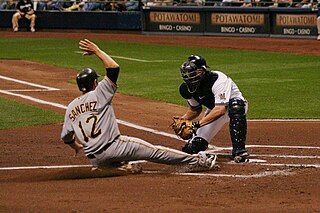
In baseball, blocking the plate is a technique performed by a catcher to prevent a runner from scoring. The act of blocking the plate accounted for most of the physical contact in Major League Baseball prior to the 2014 season, when it was outlawed except when the catcher already has possession of the ball.
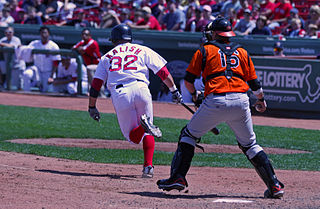
In baseball and softball, an uncaught third strike occurs when the catcher fails to cleanly catch a pitch for the third strike of a plate appearance. In Major League Baseball (MLB), the specific rules concerning the uncaught third strike are addressed in Rules 5.05 and 5.09 of the Official Baseball Rules:
In baseball, a fourth out is a legal out made by the defense after three outs in a half-inning have already been made. According to the rules, the third out does not cause the ball to become dead; if the fielders make a subsequent out that prevents a run from scoring, this out will supersede the apparent third out, thus becoming the recorded third out. The defense successfully makes an appeal while the ball is still live, and the umpire calls a temporary fourth out that (usually) replaces the existing third out. For statistical purposes, the apparent third out is "undone" and the fourth out's result is recorded instead. With the advent of video replay appeals, a new rationale for making extra out(s) has emerged: insurance against a prior out being undone on appeal. These fourth-out situations are not the same as four strikeouts in an inning.

In baseball, a baserunner is safe when he reaches a base without being put out by various ways. While a runner is touching a base, he is usually not in jeopardy of being put out, and is thus "safe" from fielders' actions, such as tags. The runner is in jeopardy once again, negating this safety, when:
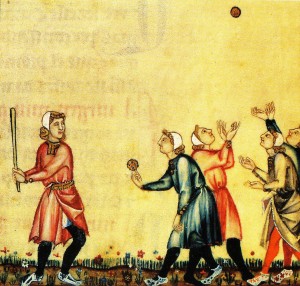
Bat-and-ball games, or safe haven games, are field games played by two opposing teams. Action starts when the defending team throws a ball at a dedicated player of the attacking team, who tries to hit it with a bat and then run between various safe areas in the field to score runs (points). The defending team can use the ball in various ways against the attacking team's players to force them off the field when they are not in safe zones, and thus prevent them from further scoring. The best known modern bat-and-ball games are cricket and baseball, with common roots in the 18th-century games played in England.
This is an alphabetical list of selected unofficial and specialized terms, phrases, and other jargon used in baseball, along with their definitions, including illustrative examples for many entries.
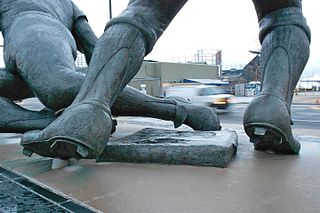
In baseball, a neighborhood play is a force play in which a fielder receiving the ball in attempting to force out a runner at second base, catches and quickly throws the ball to first base in a double play attempt without actually touching second base, or by touching second base well before catching the ball. By every rules code, such a play is not an out, because to record a force out, the fielder with the ball must actually touch a force base before the forced runner arrives.

Merkle's Boner refers to the notorious base-running mistake committed by rookie Fred Merkle of the New York Giants in a game against the Chicago Cubs on September 23, 1908. Merkle's failure to advance to second base on what should have been a game-winning hit led instead to a force play at second and a tied game. The Cubs later won the makeup game, which proved decisive as they beat the Giants by one game to win the National League (NL) pennant for 1908. It has been described as "the most controversial game in baseball history".















